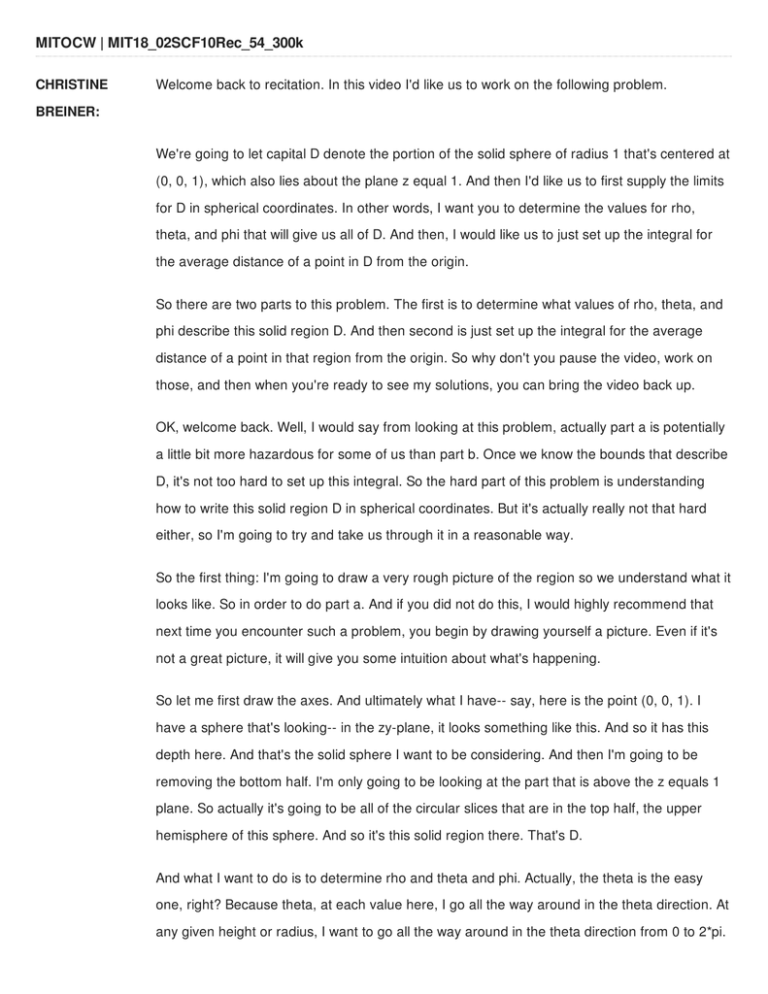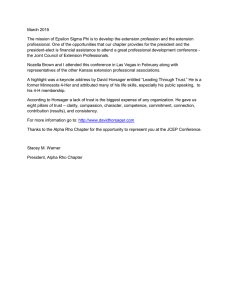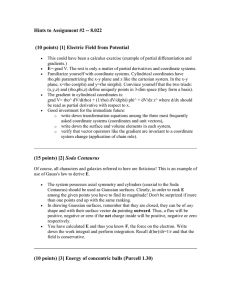MITOCW | MIT18_02SCF10Rec_54_300k
advertisement

MITOCW | MIT18_02SCF10Rec_54_300k CHRISTINE Welcome back to recitation. In this video I'd like us to work on the following problem. BREINER: We're going to let capital D denote the portion of the solid sphere of radius 1 that's centered at (0, 0, 1), which also lies about the plane z equal 1. And then I'd like us to first supply the limits for D in spherical coordinates. In other words, I want you to determine the values for rho, theta, and phi that will give us all of D. And then, I would like us to just set up the integral for the average distance of a point in D from the origin. So there are two parts to this problem. The first is to determine what values of rho, theta, and phi describe this solid region D. And then second is just set up the integral for the average distance of a point in that region from the origin. So why don't you pause the video, work on those, and then when you're ready to see my solutions, you can bring the video back up. OK, welcome back. Well, I would say from looking at this problem, actually part a is potentially a little bit more hazardous for some of us than part b. Once we know the bounds that describe D, it's not too hard to set up this integral. So the hard part of this problem is understanding how to write this solid region D in spherical coordinates. But it's actually really not that hard either, so I'm going to try and take us through it in a reasonable way. So the first thing: I'm going to draw a very rough picture of the region so we understand what it looks like. So in order to do part a. And if you did not do this, I would highly recommend that next time you encounter such a problem, you begin by drawing yourself a picture. Even if it's not a great picture, it will give you some intuition about what's happening. So let me first draw the axes. And ultimately what I have-- say, here is the point (0, 0, 1). I have a sphere that's looking-- in the zy-plane, it looks something like this. And so it has this depth here. And that's the solid sphere I want to be considering. And then I'm going to be removing the bottom half. I'm only going to be looking at the part that is above the z equals 1 plane. So actually it's going to be all of the circular slices that are in the top half, the upper hemisphere of this sphere. And so it's this solid region there. That's D. And what I want to do is to determine rho and theta and phi. Actually, the theta is the easy one, right? Because theta, at each value here, I go all the way around in the theta direction. At any given height or radius, I want to go all the way around in the theta direction from 0 to 2*pi. So my theta bounds are the easy ones. I'm covering 0 to 2*pi in theta. Because if I cut off the back half of the sphere, I want to only have a restricted value of theta. But because I'm covering all the way around and my restriction is only in the bottom half, my theta values haven't changed. So theta is easy: 0 and 2*pi. Now the harder ones are going to be rho and phi. But in fact, actually, phi is not that hard either. I notice phi is the angle that I make from the z-axis to any given point. So I notice that I certainly am including the point where phi is 0, and then I'm going all the way down to a point out here, which is a 45 degree angle with the z-axis. So phi is also easy. It's actually just between 0 and pi over 4. And the rho will be the slightly harder part. So that's really the only really tricky part in this problem is determining the rho value. Now, the rho value, to get the outer boundary, we'll look at that part first. Well, the boundary of this sphere here has a certain equation in x, y, and z that we know, right? It's x squared plus y squared plus the quantity z minus 1 squared equals 1. I mean, that's just the equation for a sphere of radius 1 centered at (0, 0, 1). So I'm going to write that here, and we're going to show how we can manipulate that. Right? x squared plus y squared is r squared. r squared is rho squared sine squared phi. So I can replace this by rho squared sine squared phi. If you didn't know that immediately, you could make the substitution for x and y in spherical coordinates, and it simplifies to this. So either way, if you didn't know r squared was this, you can get it from just doing the substitution. And then z is going to be rho cosine phi. So here, I'm going to have a rho cosine phi minus 1 quantity squared equals 1. This, in the spherical coordinates, is describing the boundary of this entire sphere, right? And so I can actually simplify this. It's not too hard. If I square this, I get a little cancellation. And then because I want my rho to be-- I'm assuming in this region, rho is greater than 0-- I can do a little simplification. I come up with the fact that rho is equal to 2 cosine phi. And let's describe exactly where that is. That's the entire boundary of this entire sphere is described by rho is equal to 2 cosine phi. And so I want to think about what my bounds are for rho. Actually, I'm going to grab a piece of colored chalk. If I start at the origin, I think about what is rho? So say this is a point on the boundary of the sphere. I am going to start my rho value-- whatever it is when it hits the plane z equals 1-- and I'm going to stop it when it hits the boundary of this sphere. So my outer boundary for rho is going to be this value. It's going to be determined by phi, right? And now I have to determine my inner boundary, right? And my inner boundary is actually quite simple. It's a very simple geometric thing. And so my inner boundary deals with the fact that if this is my plane z equals 1, and I look at this triangle I make right here. This angle down here, the bottom angle is phi, and this is a right angle, and the rho value I'm interested in is this hypotenuse, right? I need to figure out what the length of this is right here. And you can see it right away from just the fact that phi is this angle here, you get rho is secant phi. So the bottom boundary comes from just simple geometry. You get this length is 1 here. So you get rho is equal to secant phi, right? This length here is 1, this is the rho I'm interested in-the blue part here-- and so rho is equal to secant phi is the lower bound. And it's equal to 2 cosine phi at the upper bound, OK? And the thing I want to be careful of is I'm not supposed to include-- it won't matter for the integral-- but I'm not supposed to include the plane. Let me write this, and make sure. Rho is going to be greater than secant phi and it's going to be less than or equal to 2 cosine phi, right? Right? So let me double-check and make sure I didn't make a geometry mistake here, just to be sure. This picture tells me that cosine phi is equal to 1 over rho. That's good. So rho is equal to 1 over cosine phi. So I get secant phi there. So my rho values start at the secant phi length and they go to the 2 cosine phi length. I know maybe I'm beating a dead horse here, but I want to make sure we understand where the rho values are coming from. So actually, I have all the bounds I need now. I have the theta bounds, and I have the phi bounds, and the rho bounds. Now you notice that theta and phi don't depend on the other variables, but rho depends on phi. So we're going to have to integrate that first. So now we can deal with part b. Part b-- let's come back over and remind ourselves what it said-- said set up the integral for the average distance of a point in D from the origin. So I'm taking the average value of a function. What is that function I'm averaging? How do I find the distance from the origin? Well, the distance from the origin is a great function to have in spherical coordinates, because it's just rho. So the function I'm supposed to average over is the function rho. In spherical coordinates, that's the function. So let me write down what we're going to have here. So in part b, the average distance is going to equal 1 divided by the volume of D times the triple integral over D of the function rho dV, OK? So now I have to write dV in the spherical coordinates, and I have to write D in the spherical coordinates bounds. And then I know I have to figure out the volume of D. So we're going to figure out each of these things, and then we'll be done. All right. So first, what is the volume of D? Well, the volume of D, let's think about what it is. It's a sphere of radius 1. And so the volume of a sphere of radius 1 is 4/3 pi r cubed. And I want half of that. So I want 2/3. Since my radius is 1, I just have to do 2/3 pi. So the first part is 1 divided by 2/3 pi. That's the volume of a half-sphere of radius 1. And now let's integrate. I'll leave a little space to write my bounds. I'm going to write the bounds last, after I have everything in order over here. dV is rho squared sine phi d rho d theta d phi. So I'm going to end up with a rho cubed sine phi d rho d theta d phi, right? The dV gave me an extra rho squared and a sine phi. That whole part is dV. And then I keep one rho from the fact that the distance function is rho. And so I get a rho cubed there. So hopefully that makes sense. Now for d rho, I know the bounds are secant phi to 2 cosine phi. For d theta, my bounds are 0 to 2 pi. And for d phi, my bounds were 0 to pi over 4. I didn't make you evaluate it, I'm just making you set it up. That actually is the solution we wanted for part b. I wanted to average the distance from any point in D to the origin. So I just took the average value of the function rho over that region D. And so that's how you finish that up. And so in this problem, basically we want you to get really familiar with how to do some things in these spherical coordinates, which are sometimes a little hard to do. But if you noticed, what we were doing in trying to figure out the bounds-- in particular, trying to figure out rho-- we took what we knew in the x-, y-, z-coordinates about certain relationships, and then we replaced the x-, y-, z-values by the values in terms of rho and theta and phi, and you can simplify to figure out the relationships you have between rho and theta and phi for the boundary value. So that was one of the techniques we were using there. And hopefully, the geometric understanding of why these angles go from 0 to 2*pi and 0 to pi over 4 is clear. And actually, the fact that this is rho equals 2 cosine phi should remind you of the two-dimensional case where you had some problem like r equals 2 cosine theta. And that drew a circle off-center from the origin. It's the analogous thing happening here. Maybe I should stop there before I say too many things. But again, the object of this was just to get really comfortable with spherical coordinates, and I hope it's helped you. I'll stop there.



